End of the Month Film Report: June 2006 Part II

10. Constantine (2005) Francis Lawrence. This film was not critically well-received when released. If I was a fan of the comic seies on which is based, Constantine: Hellblazer, developed by legendary comic book writer Alan Moore in 1985, I would likely be disappointed. Moore's John Constantine is a chain-smoking demon chaser who sees half-breed evil and angels where the rest of us just see everyday life (all that anger towards "half-breeds" and its implicit analogy of racism wasn't dealt with in the film). He cast the demons back to hell, well for the hell of it and to "be-devil the devil." The film is virtually absent the comic's running critique of Thatcher-Reaganomics and the classicism of the 1980s--which featured BMW driving archangels who could care less abou the human condition. The location has been changed from London to Los Angeles, and the character's surname doesn't even have the same pronunciation, and forget about physical resemblance between Keanu Reeves and the character (see illustration below right). I think one of the few adaptations of a celebrated comic book seried that made fans of the print work happy is Frank Miller's Sin City (see below, #11). But I love the performances in this work, and it does have a great cast. I am among those folks who appreciate Keanu Reeves' restrained and understated performance style. It
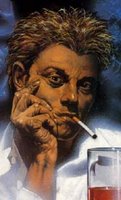 does work in futurist and speculative film contexts. Plus there's the pre-Oscar Rachel Weisz, Pruitt Taylor Vince (whom I've never seen give a bad performance), the always astonishing Tilda Swinton, surprisingly mature work by Shia LaBeouf (Holes), a juicily repellant appearance by Swedish actor Peter Stormare (Dancer in the Dark), and Djimon Hounsou as a powerful, but neutral, Vodun priest (apparently the purest character realization from the comic). After the overt politics have been cut away the story is ultimately a Bad Boy moral meditation, with impressive special effects (Hell is an endless nuclear blast), on the relationship of humans to living theology as embodied by Catholicism (after all, among Christians they've got the best holy relics). As long as you aren't expecting more, it's an engrossing world.
does work in futurist and speculative film contexts. Plus there's the pre-Oscar Rachel Weisz, Pruitt Taylor Vince (whom I've never seen give a bad performance), the always astonishing Tilda Swinton, surprisingly mature work by Shia LaBeouf (Holes), a juicily repellant appearance by Swedish actor Peter Stormare (Dancer in the Dark), and Djimon Hounsou as a powerful, but neutral, Vodun priest (apparently the purest character realization from the comic). After the overt politics have been cut away the story is ultimately a Bad Boy moral meditation, with impressive special effects (Hell is an endless nuclear blast), on the relationship of humans to living theology as embodied by Catholicism (after all, among Christians they've got the best holy relics). As long as you aren't expecting more, it's an engrossing world.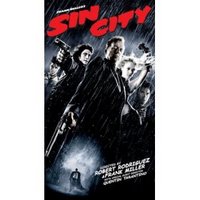 11. Sin City (2005) Dir. Robert Rodriguez and Frank Miller, with guest director Quentin Tarantino. As I was watching this film I revisted my deep regret for not having become a comic book artist/writer or graphic novelist. Sin City ably demonstrates Rodriguez's desire to create a new way to photograph film, well actually HD digital video, and I don't think I've ever seen green screen work look so lyrical and poetic. Most of Sin City's dialogue and shots are taken directly from Frank Miller's comics (everyone should have storyboards of this quality), with high contrast stylized black and white imagery; the outer edges of actors lit in white as thought they were outlined in white against a black background. In this the setting the look the digital imagery folks created is completely natural, nothing corny about it, and it is literally a comic book come to life in an unprecedented manner. Marked by a great ensemble performance what's clear is how much the film has benefited from the working relationships between Rodriguez and Tarantino and the actors with whom they've built a rapport, such as Bruce Willis, Michael Madsen, Benecio del Toro, and Mickey Rourke (pictured below as Marv) the newcomers include the great Clive Owen, Elijah Wood (in some great casting against type), Nick Stahl, Rutger Hauer, and Powers Boothe. The film is truly a romance of masculinity; as is traditional in film noir the women are spirited--with lively work by Jessica Alba, Rosario Dawson, Brittany Murphy, and Devon Aoki, and Jaime King--but mainly idealized
11. Sin City (2005) Dir. Robert Rodriguez and Frank Miller, with guest director Quentin Tarantino. As I was watching this film I revisted my deep regret for not having become a comic book artist/writer or graphic novelist. Sin City ably demonstrates Rodriguez's desire to create a new way to photograph film, well actually HD digital video, and I don't think I've ever seen green screen work look so lyrical and poetic. Most of Sin City's dialogue and shots are taken directly from Frank Miller's comics (everyone should have storyboards of this quality), with high contrast stylized black and white imagery; the outer edges of actors lit in white as thought they were outlined in white against a black background. In this the setting the look the digital imagery folks created is completely natural, nothing corny about it, and it is literally a comic book come to life in an unprecedented manner. Marked by a great ensemble performance what's clear is how much the film has benefited from the working relationships between Rodriguez and Tarantino and the actors with whom they've built a rapport, such as Bruce Willis, Michael Madsen, Benecio del Toro, and Mickey Rourke (pictured below as Marv) the newcomers include the great Clive Owen, Elijah Wood (in some great casting against type), Nick Stahl, Rutger Hauer, and Powers Boothe. The film is truly a romance of masculinity; as is traditional in film noir the women are spirited--with lively work by Jessica Alba, Rosario Dawson, Brittany Murphy, and Devon Aoki, and Jaime King--but mainly idealized props, over which men suffer, battle, periodically worship, struggle with their masculinity (sometimes in rather perverse ways), and often redeem themselves. This is the film over which Rodriguez quit the Directors Guild of America (DGA), due to their non-negotiable stance on having two directors helm a film ("it doesn't work"), he felt Frank Miller should co-direct and get the credit for having done so. To Miller's credit Rodriguez offered to lens the film and let him direct, and while Miller was tempted his scruples got the better of him and he declined at which point Rodriguez quipped, "I guess I'm leaving the DGA." Having gone that far Rodriguez invited his old buddy Quentin Tarantino to direct a segment of one of the stories. The film's success ultimately vindicated Rodriguez, he but lost work at Paramount which has a deal with the DGA only to employ guild members. Nonetheless he's slated to co-direct Sin City 2, and to produce Sin City 3, which Miller will helm alone.
props, over which men suffer, battle, periodically worship, struggle with their masculinity (sometimes in rather perverse ways), and often redeem themselves. This is the film over which Rodriguez quit the Directors Guild of America (DGA), due to their non-negotiable stance on having two directors helm a film ("it doesn't work"), he felt Frank Miller should co-direct and get the credit for having done so. To Miller's credit Rodriguez offered to lens the film and let him direct, and while Miller was tempted his scruples got the better of him and he declined at which point Rodriguez quipped, "I guess I'm leaving the DGA." Having gone that far Rodriguez invited his old buddy Quentin Tarantino to direct a segment of one of the stories. The film's success ultimately vindicated Rodriguez, he but lost work at Paramount which has a deal with the DGA only to employ guild members. Nonetheless he's slated to co-direct Sin City 2, and to produce Sin City 3, which Miller will helm alone. 12. (2006 Atlanta Film Festival) loudQUIETloud (2006) Dir. Steven Cantor. A documentary of the 2004 reunion tour of legendary Boston band The Pixies. The Pixies formed in 1986 (see left), with Black Francis aka Francis Black neé Chris Thompson IV) guitar/songwriting/lead vocals, Kim Deal (aka Mrs. John Murphey) bass/songwriting/lead and backing vocals, Joey Santiago lead guitar, David Lovering drums. They released four groundbreaking and a fifth, last album that many only rated as great--such was their genius. Although they were not really embraced in the US they had major success in the UK and Europe, and their work nevertheless influenced a number of bands including Nirvana. The film documents their somewhat tumultuous reunion, with rather naked and brave exposure on the part of band members. Each of them seems to have been floating since the Pixie's abrupt demise in 1993 (Black Francis announced the band was splitting in a radio interview without telling the rest of the band). Joey Santiago has been doing periodic soundtrack work, formed a band with his wife, and has two children, but is struggling financially. Kim Deal's drug use and alcoholism is revealed in the film; in the past it was twin sister Kelley whose heroin addiction got the most press, especially when it sidelined the sisters' innovative band, the Breeders. Kim's been living at home with her
12. (2006 Atlanta Film Festival) loudQUIETloud (2006) Dir. Steven Cantor. A documentary of the 2004 reunion tour of legendary Boston band The Pixies. The Pixies formed in 1986 (see left), with Black Francis aka Francis Black neé Chris Thompson IV) guitar/songwriting/lead vocals, Kim Deal (aka Mrs. John Murphey) bass/songwriting/lead and backing vocals, Joey Santiago lead guitar, David Lovering drums. They released four groundbreaking and a fifth, last album that many only rated as great--such was their genius. Although they were not really embraced in the US they had major success in the UK and Europe, and their work nevertheless influenced a number of bands including Nirvana. The film documents their somewhat tumultuous reunion, with rather naked and brave exposure on the part of band members. Each of them seems to have been floating since the Pixie's abrupt demise in 1993 (Black Francis announced the band was splitting in a radio interview without telling the rest of the band). Joey Santiago has been doing periodic soundtrack work, formed a band with his wife, and has two children, but is struggling financially. Kim Deal's drug use and alcoholism is revealed in the film; in the past it was twin sister Kelley whose heroin addiction got the most press, especially when it sidelined the sisters' innovative band, the Breeders. Kim's been living at home with her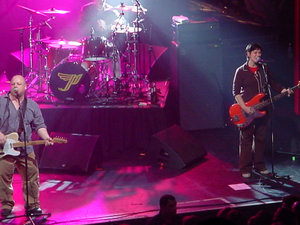 parents during her recovery. Kelley accompanies her sister on the reunion tour to provide moral support as Kim Deal ventures out on tour for the first time since becoming sober (Kim requests that there be no alcohol in the dressing rooms--they toast their first show with non-alcoholic champagne). Real fear is apparent in her eyes when the band is getting ready to play New York City, which clearly was a major scoring locale in her past. David Lovering had become a magician, "the Scientific Phenomenalist," since leaving the band and sometimes opens the re-formed Pixie shows. Lovering's been surviving on those earnings plus healthy Pixies royalty checks, but music downloads have cut into the band's profits. Sadly, he loses his father while on tour leading to self medicating, bad playing, and serious rifts in the band. There are great moments with fans, including some girls who have started a Pixies tribute band and consider Kim Deal as something of a god (she was referred to as the "goddess of cool" back in the day). The film shows the mundane moments of touring, with folks keeping themselves busy on the tour buses, the two fathers, Black Francis and Santiago missing their kids and companion/wife. Black Francis gives the camera much access to his insecurities including interviews where he keeps changing the answer to inquiries about a new Pixies album and if he's written any new songs. Alone, often half-naked with an abundant middle-aged gut, he says honestly all of his post-Pixies work has been overshadowed by the Pixies. Santiago talks about how hard Deal's major post-Pixies success with the Breeders must have been for Francis (especially since tension between the two over songwriting had led to the break up). At the end of the day we see Francis climb into his tour bus berth and listen to affirmation tapes: "I am a good person and people like me." The band is a study in poor communication, seeing them on tour it's a wonder they stayed together for as long as they did. Offstage they barely talk to each other, it's not dislike, rather an inability to communicate any way but musically; onstage they're a tightly coordinated series of intricate explosions--really powerful.
parents during her recovery. Kelley accompanies her sister on the reunion tour to provide moral support as Kim Deal ventures out on tour for the first time since becoming sober (Kim requests that there be no alcohol in the dressing rooms--they toast their first show with non-alcoholic champagne). Real fear is apparent in her eyes when the band is getting ready to play New York City, which clearly was a major scoring locale in her past. David Lovering had become a magician, "the Scientific Phenomenalist," since leaving the band and sometimes opens the re-formed Pixie shows. Lovering's been surviving on those earnings plus healthy Pixies royalty checks, but music downloads have cut into the band's profits. Sadly, he loses his father while on tour leading to self medicating, bad playing, and serious rifts in the band. There are great moments with fans, including some girls who have started a Pixies tribute band and consider Kim Deal as something of a god (she was referred to as the "goddess of cool" back in the day). The film shows the mundane moments of touring, with folks keeping themselves busy on the tour buses, the two fathers, Black Francis and Santiago missing their kids and companion/wife. Black Francis gives the camera much access to his insecurities including interviews where he keeps changing the answer to inquiries about a new Pixies album and if he's written any new songs. Alone, often half-naked with an abundant middle-aged gut, he says honestly all of his post-Pixies work has been overshadowed by the Pixies. Santiago talks about how hard Deal's major post-Pixies success with the Breeders must have been for Francis (especially since tension between the two over songwriting had led to the break up). At the end of the day we see Francis climb into his tour bus berth and listen to affirmation tapes: "I am a good person and people like me." The band is a study in poor communication, seeing them on tour it's a wonder they stayed together for as long as they did. Offstage they barely talk to each other, it's not dislike, rather an inability to communicate any way but musically; onstage they're a tightly coordinated series of intricate explosions--really powerful.13. Pulp Fiction (1994) Dir. Quentin Tarantino. Hey, don't look at the screen that way. Most people haven't seen Cauleen's Smith's sadly overlooked Drylongso (1998) which also
 looks at the small everyday moments between people, but no hit men, although there is violence. Anyway, it took me eleven years to get over being ticked at Quentin Tarantino for thinking that he could just use the N-word like another curse word (or that he was as black as Spike Lee, wha-at!). Then I saw Kill Bill 1 & 2 last year after a student had intended to write about the films being a two-part treatise on motherhood. And earlier this month I saw Sin City (#11), which got me intrigued again with the Rodriguez-Tarantino interpretations of the film noir genre. Let's face it Tarantino is a gifted writer and director, he has a unique vision, gets great performances out of his actors and he's shown he can write interesting female characters who can do more than be sexual (witness Maria de Madeiros' great little speech to Bruce Willis about the pleasure of pot bellies on women and the unfortunate distinction between what feels good to the touch and looks good to the eye) and there seems to be a certain reverence for cunnilingus, demonstrated in word and deed, that you just don't get from most male film makers. He's been a role model for many a frustrated indie video store clerk. But I remain ambivalent about violence in films, a number of people don't approach cinema with a love of story, but a love of the visceral and visual wherein if its enjoyable people happily injest it with as much critical thought as they would give to the great-tasting but nevertheless carcinogenic-filled movie multiplex popcorn.
looks at the small everyday moments between people, but no hit men, although there is violence. Anyway, it took me eleven years to get over being ticked at Quentin Tarantino for thinking that he could just use the N-word like another curse word (or that he was as black as Spike Lee, wha-at!). Then I saw Kill Bill 1 & 2 last year after a student had intended to write about the films being a two-part treatise on motherhood. And earlier this month I saw Sin City (#11), which got me intrigued again with the Rodriguez-Tarantino interpretations of the film noir genre. Let's face it Tarantino is a gifted writer and director, he has a unique vision, gets great performances out of his actors and he's shown he can write interesting female characters who can do more than be sexual (witness Maria de Madeiros' great little speech to Bruce Willis about the pleasure of pot bellies on women and the unfortunate distinction between what feels good to the touch and looks good to the eye) and there seems to be a certain reverence for cunnilingus, demonstrated in word and deed, that you just don't get from most male film makers. He's been a role model for many a frustrated indie video store clerk. But I remain ambivalent about violence in films, a number of people don't approach cinema with a love of story, but a love of the visceral and visual wherein if its enjoyable people happily injest it with as much critical thought as they would give to the great-tasting but nevertheless carcinogenic-filled movie multiplex popcorn. 14. Reservoir Dogs (1992) Dir. Quentin Tarantino. Yes, I can hold out a long time. After listening to the various epithets for blacks and Asians (although a lot of people don't see the problem with "Oriental") and trying to remember that Margaret Cho did date him, but the past tense may be key there, I got a little exhausted. It did occur to me that maybe I was privy to an Adrian Piper moment; this is how white people of different ancestries talk about African Americans when African Americans aren't around or the believe them not to be. Quentin Tarantino was perhaps giving us the real. This earlier work is rather stagey, and seeing it after all the hype has passed like so much smoke, it still feels violent but
14. Reservoir Dogs (1992) Dir. Quentin Tarantino. Yes, I can hold out a long time. After listening to the various epithets for blacks and Asians (although a lot of people don't see the problem with "Oriental") and trying to remember that Margaret Cho did date him, but the past tense may be key there, I got a little exhausted. It did occur to me that maybe I was privy to an Adrian Piper moment; this is how white people of different ancestries talk about African Americans when African Americans aren't around or the believe them not to be. Quentin Tarantino was perhaps giving us the real. This earlier work is rather stagey, and seeing it after all the hype has passed like so much smoke, it still feels violent but not horrifyingly so. Maybe after some of the war crimes the U.S. is being accused of, it seems a lot less unimaginable, plus it is film noir, much of which happens off-camera. The staginess, at certain points made me feel like I was watching a David Mamet play, the deliberate delivery, the minimalist mano-á-mano world. But in the end a well-written mislead, with great performances, my favorite being Steve Buscemi's ("I'm a professional!") Mr. Orange and the unexpected earnest humanity of Harvey Keitel's Mr. White.
not horrifyingly so. Maybe after some of the war crimes the U.S. is being accused of, it seems a lot less unimaginable, plus it is film noir, much of which happens off-camera. The staginess, at certain points made me feel like I was watching a David Mamet play, the deliberate delivery, the minimalist mano-á-mano world. But in the end a well-written mislead, with great performances, my favorite being Steve Buscemi's ("I'm a professional!") Mr. Orange and the unexpected earnest humanity of Harvey Keitel's Mr. White. 15. Spy Kids (2001) Dir. Robert Rodriguez. Continuing with the Rodriguez-Tarantino festivities I opted to check out Rodriguez's foray into kids fare with this adaptation of a story co-written with one of his sons. It's a playful romp, shows a universe where kids rule, and come to their own understanding of the importance of family. The big lessons being that you can forge your individual identity without using secrets as a means to create boundaries between yourself and the rest of your family members, and you can simultaneously have a strong sense of self and a deep commitment to family--heavy stuff, but not dogmatically or didactically portrayed. Well, the message that strong family bonds take work is delivered in a bit of a heavy-handed manner, but in the context of secret agent-speak, so the delivery, if not the message is a bit tongue-in-cheek. The kids Carmen (Alexa Vega) and Juni (Daryl Sabara) learn this when their parents (Antonio Banderas and Carla Gugino)are kidnapped by kids show host and musical evildoer Fegan
15. Spy Kids (2001) Dir. Robert Rodriguez. Continuing with the Rodriguez-Tarantino festivities I opted to check out Rodriguez's foray into kids fare with this adaptation of a story co-written with one of his sons. It's a playful romp, shows a universe where kids rule, and come to their own understanding of the importance of family. The big lessons being that you can forge your individual identity without using secrets as a means to create boundaries between yourself and the rest of your family members, and you can simultaneously have a strong sense of self and a deep commitment to family--heavy stuff, but not dogmatically or didactically portrayed. Well, the message that strong family bonds take work is delivered in a bit of a heavy-handed manner, but in the context of secret agent-speak, so the delivery, if not the message is a bit tongue-in-cheek. The kids Carmen (Alexa Vega) and Juni (Daryl Sabara) learn this when their parents (Antonio Banderas and Carla Gugino)are kidnapped by kids show host and musical evildoer Fegan Floop (Alan Cummings) and they have to save them. The film has a great supporting cast, with heavy Danny Trejo finally getting the chance to play a good guy on the big screen (aside from a recent guest role on Desperate Housewives helping Eva Longaria's character grieve her miscarriage), Alan Cummings as an evil cross between Pee Wee Herman and Mr. Rodgers on a Willy Wonka trip, and Tony Shalhoub as his duplicitous minion, appropriately named Mr. Minion, both performances overshadow the typically creepy chisled evil of Robert Patrick (Terminator 2). A fun romp, particularly adding some humor and celebration to the real life challenges of kids who have to grow up before their time.
Floop (Alan Cummings) and they have to save them. The film has a great supporting cast, with heavy Danny Trejo finally getting the chance to play a good guy on the big screen (aside from a recent guest role on Desperate Housewives helping Eva Longaria's character grieve her miscarriage), Alan Cummings as an evil cross between Pee Wee Herman and Mr. Rodgers on a Willy Wonka trip, and Tony Shalhoub as his duplicitous minion, appropriately named Mr. Minion, both performances overshadow the typically creepy chisled evil of Robert Patrick (Terminator 2). A fun romp, particularly adding some humor and celebration to the real life challenges of kids who have to grow up before their time.16. Dirty Pretty Things (2002) Dir. Stephen Frears. I watched this before I went to bed,
 and that woke intermittently through the night to dreams of the expressive face of Chiwetel Ejiofor. Although the success of Amelie led to the film being marketed worldwide as an Audrey Tautou vehicle, the film turns on the strength of Ejiofor's lead performance as Okwe, an undocumented Nigerian national living in Britain and working as a cab driver and hotel night clerk. Although the hotel is a posh setting, some rather unspeakable things occur there during the night shift, and Okwe, who has created a wall between himself and the rest of the world finds himself in the middle of a mystery that threatens to draw him in. Ejiofor registers the
and that woke intermittently through the night to dreams of the expressive face of Chiwetel Ejiofor. Although the success of Amelie led to the film being marketed worldwide as an Audrey Tautou vehicle, the film turns on the strength of Ejiofor's lead performance as Okwe, an undocumented Nigerian national living in Britain and working as a cab driver and hotel night clerk. Although the hotel is a posh setting, some rather unspeakable things occur there during the night shift, and Okwe, who has created a wall between himself and the rest of the world finds himself in the middle of a mystery that threatens to draw him in. Ejiofor registers the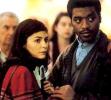 progression of his character, his restlessness, his inner conflict, his emotional denial, and the arc of a man faced with several different moralities and mortalities. The chemistry between Tatou and Ejiofor starts as a fragile thing, with him asking to cook for her in the apartment they share in shifts, due to her Turkish Muslim propriety as they each attempt to eke out a living an avoid the immigration police. But her character is nevertheless drawn to him; he so clearly has a big beating heart he's trying to silence. Meanwhile the larger mystery of the hotel threatens to destroy them because of their unique vulnerability in a society in which they are not supposed to exist.
progression of his character, his restlessness, his inner conflict, his emotional denial, and the arc of a man faced with several different moralities and mortalities. The chemistry between Tatou and Ejiofor starts as a fragile thing, with him asking to cook for her in the apartment they share in shifts, due to her Turkish Muslim propriety as they each attempt to eke out a living an avoid the immigration police. But her character is nevertheless drawn to him; he so clearly has a big beating heart he's trying to silence. Meanwhile the larger mystery of the hotel threatens to destroy them because of their unique vulnerability in a society in which they are not supposed to exist. 17. The Order: From Cremaster 3 (2002) Dir. Matthew Barney. Recently the New York Times reviewed Barney's latest work, Restraint 9, a collaboration with his wife, avant-pop muse Björk, who appears with Barney in the film despite her declaration that she would never act again after her harrowing experience with director Lars von Trier in Dancer in the Dark (2000). The
17. The Order: From Cremaster 3 (2002) Dir. Matthew Barney. Recently the New York Times reviewed Barney's latest work, Restraint 9, a collaboration with his wife, avant-pop muse Björk, who appears with Barney in the film despite her declaration that she would never act again after her harrowing experience with director Lars von Trier in Dancer in the Dark (2000). The review declared that Björk brought a less clinically cerebral feel to his work. However, The Order, although it has its abstract moments to be sure, has a considerable visceral feel to it, in part because of the play on reconizable visual tropes auch as burlesque, the car show display format, Busby Berkeley musicals, and epic mythologies that include a heroes journey by way of the spiral levels of the Guggenheim Museum. By the end we have some semblance of a young man having successfully faced the varied trials of his journey--a stand off with a line of tap dance girls,
review declared that Björk brought a less clinically cerebral feel to his work. However, The Order, although it has its abstract moments to be sure, has a considerable visceral feel to it, in part because of the play on reconizable visual tropes auch as burlesque, the car show display format, Busby Berkeley musicals, and epic mythologies that include a heroes journey by way of the spiral levels of the Guggenheim Museum. By the end we have some semblance of a young man having successfully faced the varied trials of his journey--a stand off with a line of tap dance girls, dueling punk bands and an enthused circling mosh pit, an alternately dangerous and beneficent cheetah woman/white goddess played by double amputee athlete/model, Aimee Mullins, and bubble bath bathing beauties/hostesses--to be metaphorically reborn only to have to initiate his journey once again. Once again Barney's obsession with vaseline is in evidence with artist Richard Serra ritualistically melting it, hurling it, and ushering it down the museum's spiraled path.
dueling punk bands and an enthused circling mosh pit, an alternately dangerous and beneficent cheetah woman/white goddess played by double amputee athlete/model, Aimee Mullins, and bubble bath bathing beauties/hostesses--to be metaphorically reborn only to have to initiate his journey once again. Once again Barney's obsession with vaseline is in evidence with artist Richard Serra ritualistically melting it, hurling it, and ushering it down the museum's spiraled path.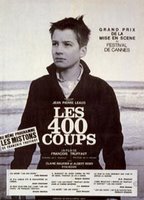 18. Les Quatre cents coups/The 400 Blows (1959) Dir. François Truffaut. I am embarassed to admit I had seen parts of this, but never the entire film . This time it was the more recently restored version with a new subtitle translation, which still had a few inaccuracies, but is supposedly better than the previous version. Of course this is a brilliant film, and the work of the young lead actor Jean-Pierre Léaud, it is actually better than Ana Torrent in Cria Cuevos (see Part I, #1), and that's saying something cause Torrent had nary a flaw that I could discern in that performance. It's just that Léaud and Truffaut apparently developed a symbiosis in this film and it's a very natural yet nuanced performance. And of course Léaud recreated this character for four more films directed by Truffaut, an amazing collaboration, but also a rich character. Although some of the depth and affability of the character can be attributed to it being based on Truffaut himself, I realize that I rarely see films these days where I am wondering what happened to that character after the film was over, where I had the desire to see the next installment. I could say this was the case for Bree and Toby in Transamerica and Okwe in Pretty Dirty Things, although in the last case the character declares his probable fate midway through the film.
18. Les Quatre cents coups/The 400 Blows (1959) Dir. François Truffaut. I am embarassed to admit I had seen parts of this, but never the entire film . This time it was the more recently restored version with a new subtitle translation, which still had a few inaccuracies, but is supposedly better than the previous version. Of course this is a brilliant film, and the work of the young lead actor Jean-Pierre Léaud, it is actually better than Ana Torrent in Cria Cuevos (see Part I, #1), and that's saying something cause Torrent had nary a flaw that I could discern in that performance. It's just that Léaud and Truffaut apparently developed a symbiosis in this film and it's a very natural yet nuanced performance. And of course Léaud recreated this character for four more films directed by Truffaut, an amazing collaboration, but also a rich character. Although some of the depth and affability of the character can be attributed to it being based on Truffaut himself, I realize that I rarely see films these days where I am wondering what happened to that character after the film was over, where I had the desire to see the next installment. I could say this was the case for Bree and Toby in Transamerica and Okwe in Pretty Dirty Things, although in the last case the character declares his probable fate midway through the film.19. Kids (1995) Dir. Larry Clark. I was loathe to see this when it came out. I read a number
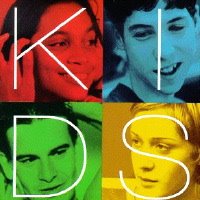 of critics vociferously taking Clark to task for representing African American males as beastial predators. Those sorts of betrayals/portrayals are prolific enough in mainstream films I don't really want to see it in the work of those granted the imprimatur of the art house critic embrace. But time has passed; a few years ago I met a skateboarder kid turned academic who told me that really was the scene, and that he knew some of those kids. Plus I do really like Rosario Dawson and Chlöe Sevigny, and I was somewhat assuaged by not having to pay to see it. It was compelling but disturbing, it bears the aesthetic of a documentary photographer-turned-filmmaker, which is apparently why people thought it was a documentary and threatened to beat up Leo Fitzpatrick mistaking him for Telly, the HIV-positive "virgin surgeon". If people had really paid attention they would have noticed the beautiful cinematography apparent throughout the film, and questioned the documentary assesment. Interestingly, although one of the popular images from Kids shows African American supporting actor/skateboarder Harold Hunter (Harold), with a distorted expression that makes him appear particularly unattractive and hostile and his central foreground placement posits him as an evil leader, most of the violence is perpetrated by white kids (rape, physical assault) with a particularly nasty beating received by an African American male (he's finished off with a skateboard to the head). Kids did remind me of aspects of being a teenager (and grateful I'm not one anymore) and grateful for the parents I know who stay involved in their kids' lives and the kids who take their own and others lives seriously enough to want to be truly engaged in life, and love their bodies enough to learn about them and how to keep them safe. Sadly, three of the actors/skateboarders from the film have died since the film's release, Hunter in February of this year from an apparent cocaine overdose; Justin Pierce (Casper), who committed suicide in 2000; and Sajan Bhagat (Paul) in 1999.
of critics vociferously taking Clark to task for representing African American males as beastial predators. Those sorts of betrayals/portrayals are prolific enough in mainstream films I don't really want to see it in the work of those granted the imprimatur of the art house critic embrace. But time has passed; a few years ago I met a skateboarder kid turned academic who told me that really was the scene, and that he knew some of those kids. Plus I do really like Rosario Dawson and Chlöe Sevigny, and I was somewhat assuaged by not having to pay to see it. It was compelling but disturbing, it bears the aesthetic of a documentary photographer-turned-filmmaker, which is apparently why people thought it was a documentary and threatened to beat up Leo Fitzpatrick mistaking him for Telly, the HIV-positive "virgin surgeon". If people had really paid attention they would have noticed the beautiful cinematography apparent throughout the film, and questioned the documentary assesment. Interestingly, although one of the popular images from Kids shows African American supporting actor/skateboarder Harold Hunter (Harold), with a distorted expression that makes him appear particularly unattractive and hostile and his central foreground placement posits him as an evil leader, most of the violence is perpetrated by white kids (rape, physical assault) with a particularly nasty beating received by an African American male (he's finished off with a skateboard to the head). Kids did remind me of aspects of being a teenager (and grateful I'm not one anymore) and grateful for the parents I know who stay involved in their kids' lives and the kids who take their own and others lives seriously enough to want to be truly engaged in life, and love their bodies enough to learn about them and how to keep them safe. Sadly, three of the actors/skateboarders from the film have died since the film's release, Hunter in February of this year from an apparent cocaine overdose; Justin Pierce (Casper), who committed suicide in 2000; and Sajan Bhagat (Paul) in 1999.20. Merci Docteur Rey (2002) Dir. Andrew Litvack. OK, here's where I don't get 2 hours of my life back. So why should I make you suffer as well? Simply put: a mostly great cast, a difficult genre: continental comedy murder mystery, poor direction, and inconsistent editing. But if you liked Gaudi Afternoon (2001), you'll probably like this. The end.
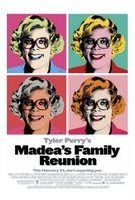 21. Medea's Family Reunion: The Movie (2006) Dir. Tyler Perry. Well Perry gave himself, and only himself, above the title starring credit in the return of Medea and family in the story of two sisters Vanessa (Lisa Arrindell Anderson) and Lisa (Rochelle Aytes) wrestling with their respective legacies of emotional victimization courtesy of their wounded narcissistic mother (Lynn Whitfield). Boris Kodjoe and Blair Underwood play the sisters' respective and requisite love interests. This installment of the Medea series is not as strong as Diary of A Mad Black Woman, and it is evident that's due the absence of someone of the caliber of Kimberly Elise to carry the film and to create a special chemistry with Cicely Tyson. There are moments reminiscent of the praying and tarrying women of Beloved (1998), casting out the ghost of Sethe's child, and Beah Richard's (playing Baby Sugg) sermon in the woods, as well as progeny gathering around a seated matriarchal elder similar to the scene with Nana Peazant (Cora Lee Day) in the grove in Daughters of the Dust(1991). Those are the best moments. While the painful mother-daughter relationship excavations I'm unfortunately sure have some reflection in real life, Perry's insistence on coiffed artifice makes it hard to believe any of the leads are in true distress with their perfect eyebrows, luminous soap opera-star skin, and over the top soap opera portrayals: subtlety is not really part of the Perry dramaturgy (much to the detriment of Lynn Whitfield's mother character). Once again though, Tyler endears himself with featured
21. Medea's Family Reunion: The Movie (2006) Dir. Tyler Perry. Well Perry gave himself, and only himself, above the title starring credit in the return of Medea and family in the story of two sisters Vanessa (Lisa Arrindell Anderson) and Lisa (Rochelle Aytes) wrestling with their respective legacies of emotional victimization courtesy of their wounded narcissistic mother (Lynn Whitfield). Boris Kodjoe and Blair Underwood play the sisters' respective and requisite love interests. This installment of the Medea series is not as strong as Diary of A Mad Black Woman, and it is evident that's due the absence of someone of the caliber of Kimberly Elise to carry the film and to create a special chemistry with Cicely Tyson. There are moments reminiscent of the praying and tarrying women of Beloved (1998), casting out the ghost of Sethe's child, and Beah Richard's (playing Baby Sugg) sermon in the woods, as well as progeny gathering around a seated matriarchal elder similar to the scene with Nana Peazant (Cora Lee Day) in the grove in Daughters of the Dust(1991). Those are the best moments. While the painful mother-daughter relationship excavations I'm unfortunately sure have some reflection in real life, Perry's insistence on coiffed artifice makes it hard to believe any of the leads are in true distress with their perfect eyebrows, luminous soap opera-star skin, and over the top soap opera portrayals: subtlety is not really part of the Perry dramaturgy (much to the detriment of Lynn Whitfield's mother character). Once again though, Tyler endears himself with featured moments from older black women actors such as Cicely Tyson (reprising her role from Diary of A Mad Black Woman), Maya Angelou, and Georgia Allen. Undeniably these black melodrama vehicles are giving African American actors an opportunity to work in movies with wide exposure and industry-recognized commercial success. Perry cares about his actors and is deeply committed to giving talented musicians and actors exposure, including a number of the actors from his plays who appear in bit speaking parts. With his revisitation of the Christian morality play formula is Perry the Oscar Micheaux or the Eloise King Patrick Gist of this generation? Next up to carry a Perry film is Gabrielle Union, who hasn't proven herself to have the range of a Kimberly Elise, but has effectively communicated intelligence and strong personality on the screen. Union will play a successful woman who gets involved with a janitor and faces her father's disapproval in Daddy's Little Girl, due in 2007 . This film also features former members of New Edition (but not Bobby), R&B singer Avant, the young McClain sisters, little girls who have a group "3mcclaingirls", but then again it also has Idris Elba ("The Wire"), Brian J. White--who apparently gave a solid performance in The Family Stone as the gay son's partner--and Academy Award winner Louis Gossett Jr. Does this mean venerated older male actors will start showing up in Perry's work? Will we be seeing Bernie Casey, Bill Cobb? Please somebody besides Perry's dyspeptic/flatulent Joe...
moments from older black women actors such as Cicely Tyson (reprising her role from Diary of A Mad Black Woman), Maya Angelou, and Georgia Allen. Undeniably these black melodrama vehicles are giving African American actors an opportunity to work in movies with wide exposure and industry-recognized commercial success. Perry cares about his actors and is deeply committed to giving talented musicians and actors exposure, including a number of the actors from his plays who appear in bit speaking parts. With his revisitation of the Christian morality play formula is Perry the Oscar Micheaux or the Eloise King Patrick Gist of this generation? Next up to carry a Perry film is Gabrielle Union, who hasn't proven herself to have the range of a Kimberly Elise, but has effectively communicated intelligence and strong personality on the screen. Union will play a successful woman who gets involved with a janitor and faces her father's disapproval in Daddy's Little Girl, due in 2007 . This film also features former members of New Edition (but not Bobby), R&B singer Avant, the young McClain sisters, little girls who have a group "3mcclaingirls", but then again it also has Idris Elba ("The Wire"), Brian J. White--who apparently gave a solid performance in The Family Stone as the gay son's partner--and Academy Award winner Louis Gossett Jr. Does this mean venerated older male actors will start showing up in Perry's work? Will we be seeing Bernie Casey, Bill Cobb? Please somebody besides Perry's dyspeptic/flatulent Joe...

1 Comments:
zzzzz2018.6.22
moncler jackets
christian louboutin sale
ralph lauren uk
ray ban eyeglasses
super dry
nike factory outlet
superdry clothing
true religion outlet
ralph lauren uk
pandora charms
Post a Comment
<< Home